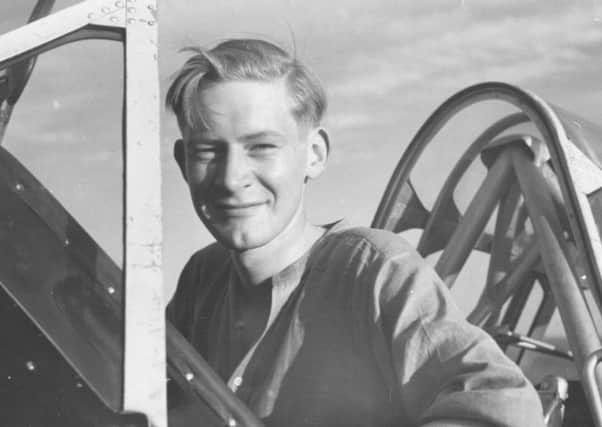Obituary: David Ince, Second World War fighter pilot


Glasgow-born David Ince, a Royal Artillery officer, won a Distinguished Flying Cross (DFC) as a pilot with RAF Hawker Typhoon ground-attack squadrons harrying Nazi factories, trains, traffic and retreating armies from Normandy across north-west Europe until Allied victory in May 1945.
The son of a director of a Glasgow firm that supplied explosives for civil engineering, he was seconded from the army to the RAF, and distinguished himself by devising new means of close-up reconnaissance photography. He also test-flew for, and took part in, the only known operational use of napalm against the enemy in Europe; and would become, after the war, a record-breaking competitive glider pilot.
Advertisement
Hide AdAdvertisement
Hide AdThe napalm attack, on a German strongpoint near Arnhem, took place on 12 April 1945. Conventional weapons were also used, and the Allies quickly overran the place. The napalm landed wide of the German troops, but devastated their morale.
“The fiery mass sprayed forward and upwards, in a cascade of incandescent reds and yellows which threatened to engulf my tail”, Ince recorded of what happened when he dropped the unwieldy eight-foot long barrel-shaped napalm container from his Typhoon. He had made test runs at a site in the Netherlands. He concluded that, because the barrel tumbled on release, it had to be dropped from as low as possible for accuracy. He discovered later that the boffins at home had warned against low drops.
Ince flew almost 150 sorties with 193 and 257 squadrons. For reconnaissance, he modified the Typhoon’s front gun-mouldings to take an F 24 camera, and came back with close-ups not achieved before.
Eager to have the chance to fly the Typhoon with its mighty Sabre engine, Ince had got his way by telling the recruiting wing-commander how a childhood injury that had shortened his right index finger made it easier for him to fly British, rather than American, aircraft. British ones had a spade-grip control and thumb-firing button. US ones required the pilot to pull levers and press with the finger. The astonished wing-commander could not believe his luck: with a death-rate of one in three – 150 of the 450 Typhoon pilots would be lost by the war’s end, some summarily executed on capture by the SS – he had been wondering how to persuade replacement pilots to take on the challenge.
Ince did not, however, reveal exactly how he had got the mangled finger he called “Stumpy”.At the age of seven, or not much older, he had tried sticking his finger into the spinning spokes of his bicycle, to see what would happen. He remained puzzled until much later in life at what he considered the lack of support for his fighter-pilot ambition from his parents, Douglas, who as a Major in the First World War had won a Military Cross, and his mother, Isobel.
Ince’s first experience of flying was when he persuaded a member of the Renfrew Flying Club to take him up over the Clyde in a Gipsy Moth.
He was educated at Kelvinside Academy and went on to Aysgarth School, Yorkshire, and then Cheltenham College.
To his dismay he failed an eyesight test for the RAF, and with war looming, he joined, in Glasgow, No. 602 Auxiliary Squadron. He found out that with 18 months’ commissioned service in the Army, he could be seconded to fly as a pilot with the RAF. Having passed another sight test, he trained to fly in Canada.
Advertisement
Hide AdAdvertisement
Hide AdDuring the Allied invasion of Europe he survived being hit while photographing Gestapo headquarters in Rotterdam; helped destroy a 200ft bridge that plunged in one piece into the river it spanned; and had a one-eleventh credit for hitting a Blohm & Voss flying boat.
One raid, on 3 May 1945, was supposed to be against escaping Nazi leaders bent on establishing a last redoubt in Norway. It emerged later that the Typhoons unknowingly killed concentration camp survivors crammed by the Germans on to ships, including the Cap Arcona , in Lubeck Bay.
After the war Ince joined the Empire Test Pilots’ School, but chronic sinusitis prevented a career trialling high-altitude jets. He took to gliding, and in 1958 broke the British local distance record with a 315-mile flight from Lavenham in Suffolk to Land’s End. He was aviation expert for a manufacturing company, Elliotts, which supplied flight systems for Lightning and Buccaneer military jets, and later Concorde.
In 1954 he wed Anne Burton, and they had two daughters, Virginia and Rosalind. Anne died in 1993. He is survived by his daughters, and sister Rosemary, who in wartime worked with codebreakers at Bletchley Park. He published two books, Combat and Competition in 1992, and Brotherhood of the Skies in 2010. Ince considered himself a native of the Borders, with fond memories of his father’s farm before the move to a grim 1930s Glasgow. He enjoyed fly-fishing for trout, and was a sought-after dinner guest, treating friends to his catch, exquisitely smoked by a smokery near his favourite angling spot.
ANNE KELENY